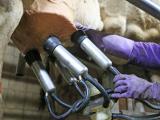Sep 28, 2006 (CIDRAP News) – A study in which mice were infected with the resurrected 1918 Spanish influenza virus has yielded fresh evidence for the view that the virus could trigger a suicidal immune response—one that has often been compared with the effects of the H5N1 avian flu virus on susceptible humans.
Scientists infected different groups of mice with a fully reconstructed version of the 1918 virus and with hybrid flu viruses containing only some of the 1918 virus genes. Mice exposed to the complete 1918 virus got sick the fastest and had the most severe lung disease, according to the report published online yesterday by Nature.
Moreover, the scientists, led by Michael G. Katze and John C. Kash of the University of Washington in Seattle, determined that the increased disease severity in mice infected with the 1918 virus was associated with a much greater activation of mouse genes that control immune responses involved in inflammation and cell death.
"Taken together these data show that r1918 [the complete 1918 virus] produced the most severe and rapid disease in mice, which could be correlated with an increased expression of inflammatory response genes similar to that reported for highly pathogenic avian influenza viruses," the report says.
The Spanish flu in 1918-19 killed as many as 100 million people worldwide. In recent years scientists have recovered samples of the virus from the frozen body of a 1918 victim in Alaska and from a US Army library of autopsy samples. This has enabled them to learn its structure and finally recreate it in an effort to figure out why it was so lethal, which could lead to new treatments for contemporary flu viruses such as H5N1.
People who have died of H5N1 infection have had severe lung damage similar to what was seen in many of the 1918 flu victims. A recent clinical study in Vietnam showed that H5N1 patients had higher levels of cytokines and chemokines—molecular messengers involved in inflammation—than patients with seasonal flu had.
The mouse experiment was conducted in a biosafety level 3 laboratory at the Centers for Disease Control and Prevention in Atlanta, according to a news release from the National Institute of Allergy and Infectious Diseases (NIAID), which supported the research.
The researchers infected groups of mice with four different flu viruses: (1) an H1N1 strain collected in Texas in 1991, (2) a lab-made hybrid with two genes (hemagglutinin and neuraminidase) from the 1918 virus and the other six from the Texas H1N1 virus; (3) a hybrid containing five genes from the 1918 virus and three genes from the Texas strain, and (4) the complete 1918 virus, containing all eight genes (called r1918).
Mice exposed to the complete 1918 virus had the greatest weight loss and died the soonest, most of them within 5 days, the report says. On the first and third days of the study, those mice had about ten times as much virus in their lungs as did mice infected with the two hybrid viruses. The Texas virus induced only mild lung inflammation. Lung damage associated with the hybrid viruses and the r1918 virus ranged from moderate to severe, but was worse in r1918-infected mice.
To examine mouse gene activation in response to the infection, the researchers removed lung tissue from three mice in each group on days 1, 3, and 5 after infection and processed it to destroy any virus. They then extracted genetic material (RNA) from the lung samples and used microarrays to determine which genes were activated.
The results showed significantly greater activation of immune-related genes in the r1918-infected mice than in any of the other groups. Genes associated with cytokines and chemokines—molecular messengers involved in inflammation—and with apoptosis (cell death) "showed the most significant and earliest activation during r1918 infection," the report states.
"We clearly see a dramatic and uncontrolled immune response in the mouse lungs as early as one day following infection with the reconstructed 1918 virus," Katze commented in the NIAID news release.
A better understanding of how host immune responses contribute to severe flu cases should help scientists identify patient risk factors for severe disease and may also help in the development of new antiviral drugs, the article says.
Besides targeting the flu virus itself, scientists might develop new or improved drugs to reduce the human immune system's excessive response to the viruses, Katze said.
The authors caution that while their findings indicate that extreme inflammatory responses may contribute to the severe disease associated with the 1918 virus, "it is not possible to exclude the possibility" that those responses are a result of the severe illness rather than the cause of it. They add that studies in other animals, including ferrets, pigs, and monkeys, will be needed for a fuller understanding of the virus's virulence.
Kash JC, Tumpey TM, Proll SC, et al. Genomic analysis of increased host immune and cell death responses induced by 1918 influenza virus. Nature 2006 Sep 27 (early online publication) [Abstract]
See also:
Sep 11 CIDRAP News story "Clinical study points to cytokine storm in H5N1 cases"
Nov 16, 2005, CIDRAP News story "Lab study supports idea of 'cytokine storm' in H5N1 flu"
Oct 5, 2005, CIDRAP News story "Scientists recreate 1918 flu virus, see parallels with H5N1"



















